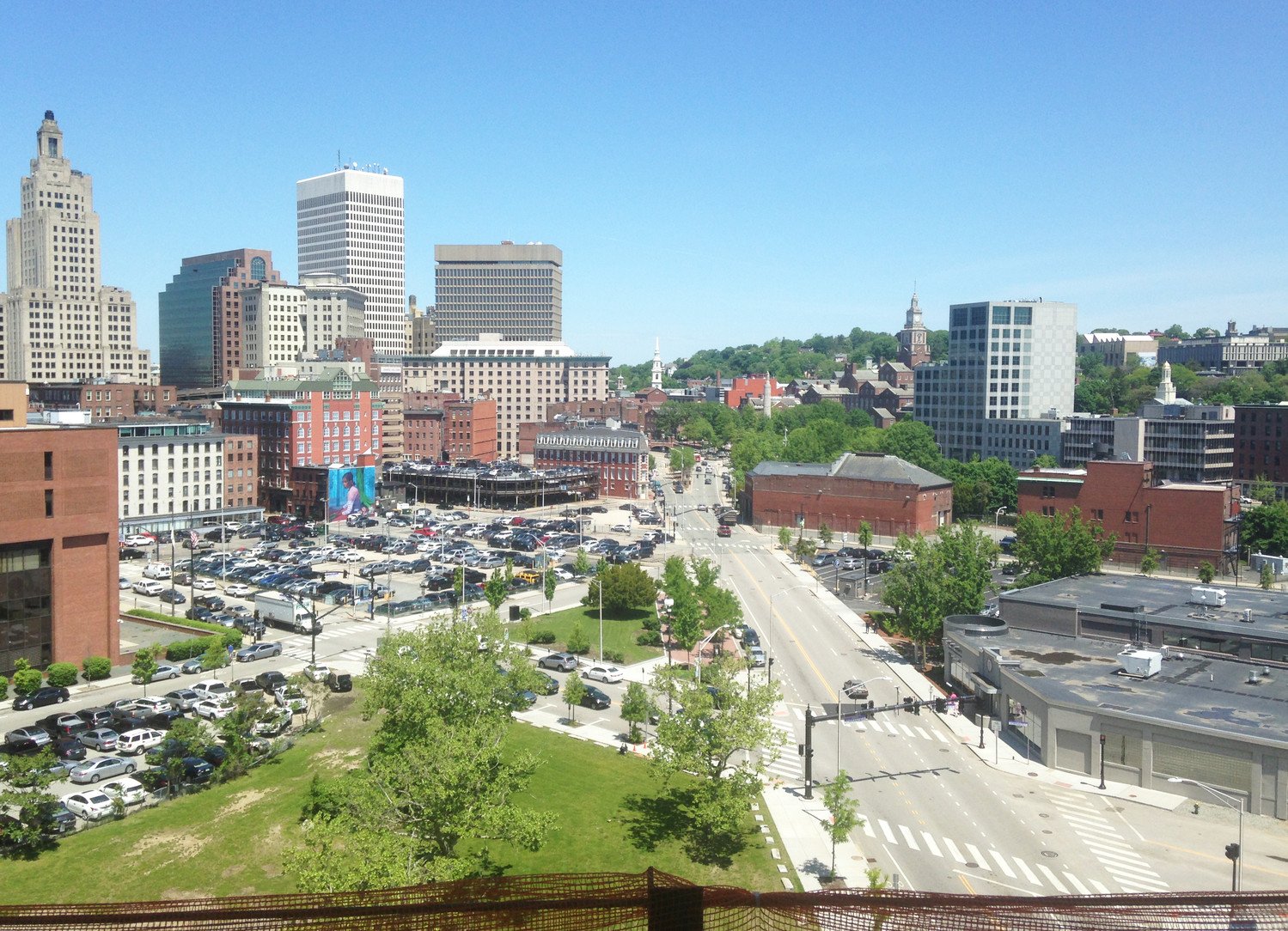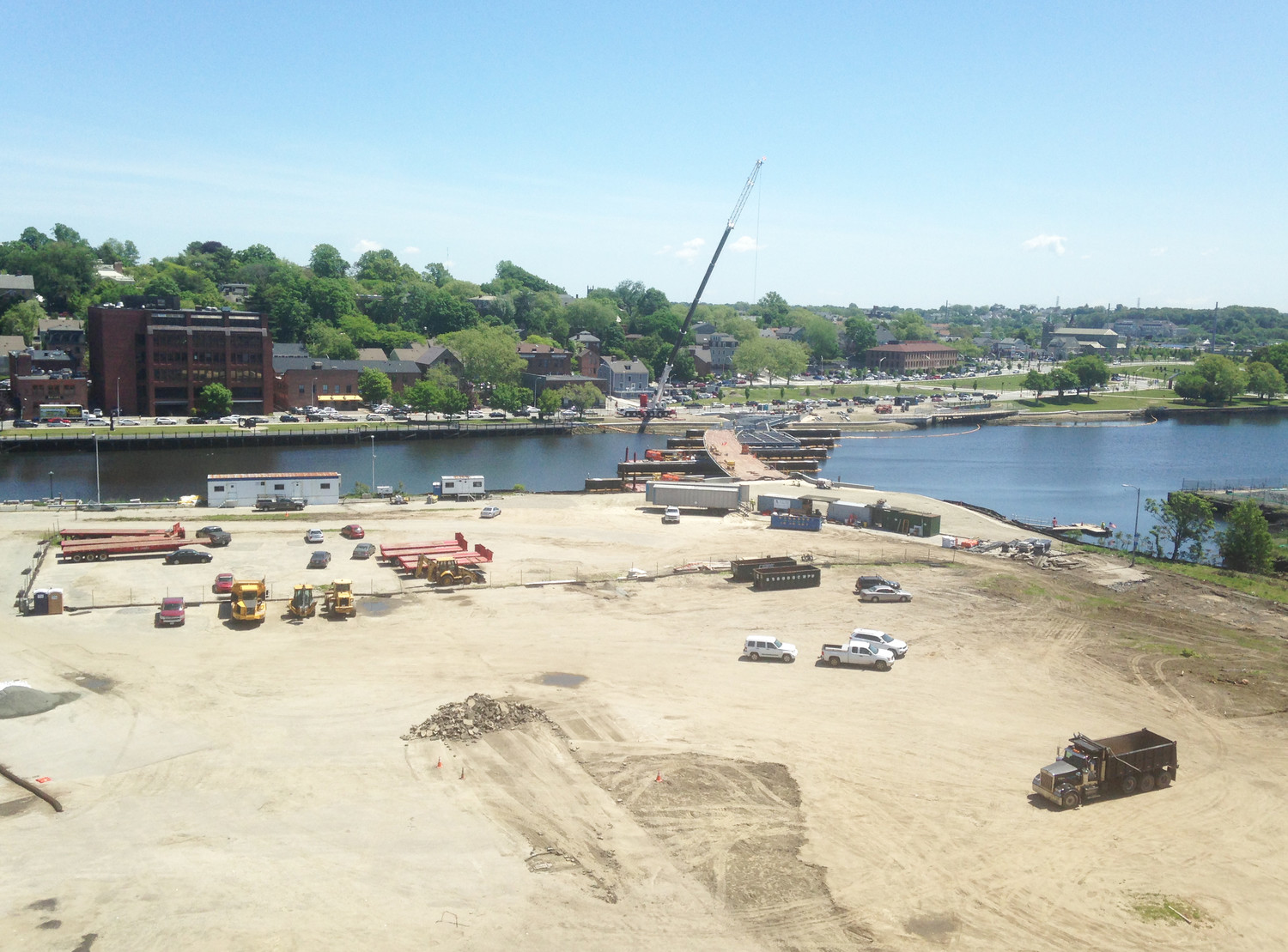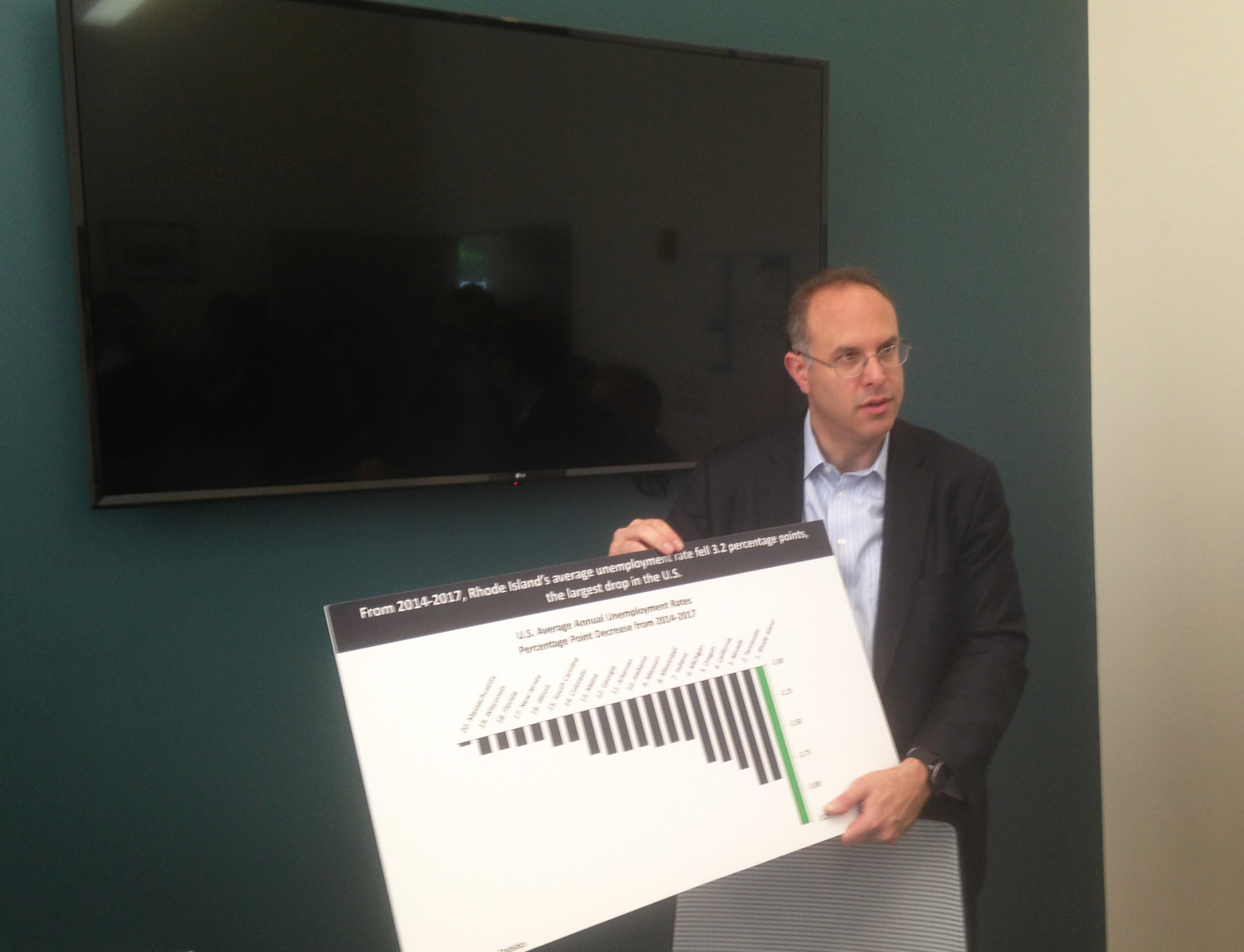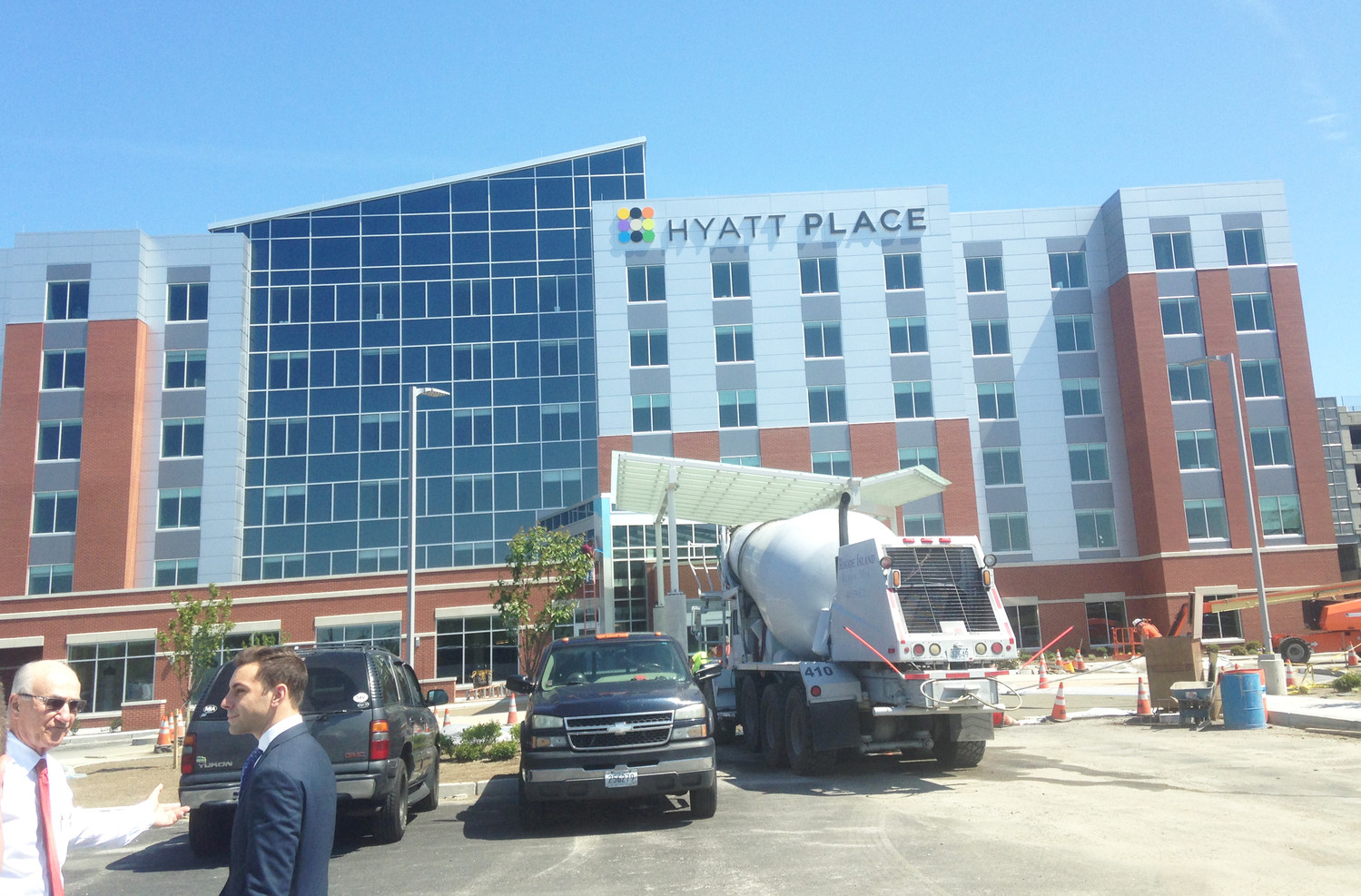Buildings with a revealing view
To help unveil the latest report touting economic development success in Rhode Island, CommerceRI’s Stefan Pryor led a media tour of three buildings now under construction in Warwick and Providence
The concept of the city as the place where collisions occur as part of a vibrant innovation ecosystem is challenged by the reality of the diseases of despair, the epidemic of death from drugs, alcohol and suicide that has afflicted young adults between the ages of 24-35 in Rhode Island, driven by isolation, economic disruption and wealth disparity.
Increasingly, the news industry is being overwhelmed by hedge funds and private equity purchases, and the question is: how do we define an engaged community in the 21st century? Is it something more than the workplace?
PART ONE
PROVIDENCE – The spectacular view of the city from the sixth floor of the Wexford Innovation Complex now under construction is unimpeded, for now.
If approved and built, the proposed Fane Tower luxury high rise would cast its dominant shadow over much of the footprint below, now a staging area for construction activities, including the pedestrian bridge over the Providence River and the Wexford building itself.
Yet, on a gorgeous spring day in May, everywhere you looked, there were clear blue skies extending toward the horizon, the downtown Providence skyline sparkled under the bright sunshine [even the Superman building appeared dazzling], and across the panorama there were numerous cranes, resembling Transformer bots, as new buildings were being erected, mostly new hotels and higher-end residential properties.
Stefan Pryor, the secretary of the Rhode Island Commerce Corporation, was ebullient, as he led an entourage of news media on Thursday, May 24, up the six flights of concrete steps, to the first public viewing from the top floor of the Wexford Innovation Complex, scheduled to open in the fall of 2019.
Members of the tour, including ConvergenceRI, Channels 6 and 10, and The Providence Journal, all had received thick packets, including the newly released, 65-page “2018 Overview of the Rhode Island Economy.” The cover featured a photo of the nation’s first offshore wind farm off the coast of Block Island, a sign that “Rhode Island’s infrastructure is strengthening,” according to the report.
For Pryor, there was much to crow about in the report:
• The annual average unemployment rate of 4.5 percent had reached a 16-year low in 2017.
• The state’s real gross domestic product, or GDP, grew by 3.8 percent over the last three quarters of 2017, the fastest rate in the Northeast and the 11th fastest rate in the U.S.
• In the third quarter of 2017, Rhode Island’s real GDP surpassed its 2007 pre-recession level for the first time and employment reached record levels.
• The metric for the average weekly earnings growth for 2017 showed Rhode Island with the largest percent growth in the nation, at 5.7 percent.
Altogether, the report concluded, the Raimondo administration’s economic development efforts “are on track to inject nearly $2 billion in investment into the Rhode Island economy.” Who could ask for anything more?
In an election year, the report’s numbers, coupled with the number of cranes in the skyline, presented a rosy vision of the Rhode Island’s economic future, indeed.
From unique to downright cool?
As if right on cue, the day before the tour, on May 23, The Boston Globe had published a travel piece that sang the praises of Providence, in gushing prose: “In the last decade, as regular weekend visitors to Providence, we have seen the waterfront capitol undergo a major cultural and artistic revival. But with the latest wave of new restaurants and hotels, the city has gone from unique to downright cool. That’s because Providence is a few cities rolled into one.”
The piece continued: “You’ll weave in and out of pockets that boast a hip West Coast vibe – art students on bikes, guitarists on street corners, tattooed baristas, skateboarders zipping past the riverfront, afternoon gondola riders.”
But wait, there’s more: “Then there’s downcity (what Providence calls downtown) where Providence Performing Arts Center and Trinity Repertory Company patrons walk streets as noticeably clean as downtown Chicago’s.”
Similar to the piece that appeared in the March 15 edition of Vogue, entitled “Why Providence should be your next weekend getaway,” The Globe story highlighted the view from the tourist perspective, a narrative oblivious to the pressures that new development has brought with it, rising rents, increasing displacement and gentrification.
A quite different narrative was delivered in the form of a study by Fay Strongin, the planner and outreach strategist for the Philadelphia Water Department, entitled, “You Don’t Have a Problem Until You Do,” looking at the connection between revitalization and gentrification in Providence, which was presented as part of a scholar series by HousingWorksRI at Roger Williams University.
Strongin’s study examined seven metrics associated with gentrification associated changes: rent growth, adult share, share of adults with a college degree, non-family household share, White share, Hispanic/Latino share, and average household income. Using these numbers as benchmarks, Strongin identified 12 potentially gentrifying neighborhoods by census track. The number that stood out was that these potentially gentrifying neighborhoods between 2000 and 2015 had seen a 47.8 percent increase in the median gross rent.
The study was discussed at a housing forum on May 25, the day after the economic development tour, featuring Strongin, Brenda Clement, director, HousingWorks RI, Teresa Guaba, community organizer, Neighbors for Revilatization, Jennifer Hawkins, executive director, ONE Neighborhood Builders, Ana Novais, executive director of Health at the R.I. Department of Health, and Taino Palermo, program director of Community Development and Healthy Communities.
The consensus was that Providence needed to create an intentional strategy, driven by community input, supporting a development without displacement policy agenda.
That narrative had been expressed eloquently by Angela B. Ankoma, executive vice president and director of Community Investment at United Way of Rhode Island and a long-time resident of the West End community of Providence, during a recent impromptu tour of the West End in March. [See link below to ConvergenceRI story, “An impromptu tour of the West End, the cultural mecca of Providence.”
“Let’s just make sure that people who live in Providence can stay in Providence,” Ankoma said. “That’s my concern. I want to be able to stay here. I want to be able to grow old here. You should be able to [do so]. There should be thoughtful, intentional actions to ensure all of us can enjoy living here.”
And, as Palermo, a resident of Cranston, said, alluding to the migration that happens as a result of gentrification and higher rents, there was a cause-and-effect reason why Cranston had surpassed Warwick as the number-two city in Rhode Island.
The larger question, which those in the audience addressed in numerous ways: how can the community pressure of an intentional policy be brought to bear on the major institutional landowners – the colleges and universities and the hospitals – when it came to student housing, subsidized parking lots, public transportation, and workforce?
All aboard
The first of three stops on the economic development media tour was the Hyatt Place Hotel in Warwick, a $23.8 million, 120-room project adjacent to T. F. Green Airport and the commuter rail station that is scheduled to open on June 19, the 17th hotel to be built in Warwick.
With Mike D’Ambra of D’Ambra Construction leading the way, the tour participants inspected the premises as the finishing touches were being put on the hotel rooms. The project is envisioned as the first phase of a much larger 540,000 square-foot redevelopment, including four office buildings and retail space. As D’Ambra told ConvergenceRI, he has the approvals needed for the project and what remains to be put together is the financing.
The new Hyatt Place hotel, will create 30 new full-time jobs, employing a workforce of Rhode Islanders, according to D’Ambra.
Glenn Ahlborg, vice president of Ahlborg Construction Corporation, a principal contractor at the Hyatt Place Hotel, approached ConvergenceRI and asked: “Don’t I know you?”
Yes, ConvergenceRI, replied; we met at the topping off celebration for the Neighborhood Health Station in Central Falls last month, being built by the Blackstone Valley Community Health Care community health center. [See link below to ConvergenceRI, “The evolution in health care will not be televised.”]
When will the Neighborhood Health Station in Central Falls be featured as part of economic development tour, ConvergenceRI wondered. Good question.
Next stop
Decked out in construction hats and bright yellow Shawmut Construction vests, the media entourage made its way to the sixth floor of the Wexford Innovation Complex, where Pryor held court and, for the benefit of the two TV cameras, expounded at length about the progress of the building and what it meant for Rhode Island.
There was a steady noisy sound of construction throughout the site. Adjacent to the building was the headquarters of Nabsys 2.0, being guided by co-founder and CEO Barrett Bready, pursuing a better way to conduct genomic analyses. Was the constant din of the construction a distraction to workers at Nabsys 2.0, ConvergenceRI wondered out loud?
Shawmut Construction, at the suggestion of CommerceRI, had laid out a buffet of food from The District, including meatballs, pizza, toasted bread and salad. The adage that the best pathway to a reporter’s heart is through his or her stomach still seemed to hold true.
Back on the bus and headed to the third stop on the tour, the new 15-story mixed-use building at 106-108 North Main St., The Edge, ConvergenceRI asked Pryor a thought that had occurred during the visit to the top of the Wexford Innovation Complex, the $105 million, 191,000-square-foot building to be anchored by the Cambridge Innovation Center, Johnson & Johnson and Brown University’s School of Professional development: had CommerceRI conducted a traffic study about the potential increase in traffic patterns, given how Point Street had already become a daily logjam in the afternoon, backing up to Davol Square?
Pryor said that he was unaware of any traffic study, with CommerceRI communications director Matt Sheaff also concurring: there was no traffic study underway.
Postcards from The Edge
Inside The Edge, a mixed-use project on adjoining lots in Providence, the construction site is a beehive of activity, with 74 days to go before Sept. 1, when the new residential building for student housing is scheduled to open, with 202 units and 214 beds, targeted at students from RISD, Brown, Johnson & Wales and Bryant. According to officials from Vision Properties, between 60 percent and 70 percent of the rooms had already been reserved. The rental cost of the apartments was between $1,500 and $2,000 a month.
In a conference room on the ground floor, Pryor took the opportunity to run through a series of large charts highlighting the accomplishments achieved in 2017, including 7,000 construction jobs created by 33 CommerceRI real estate projects, with construction job growth in 2017 being shown as a healthy 3.3 percent.
The media bus tour was a compelling narrative, with strong visuals, and great statistics to crow about. The question was: how did that narrative intersect with an equally compelling narrative about the forces of gentrification? Stay tuned.









